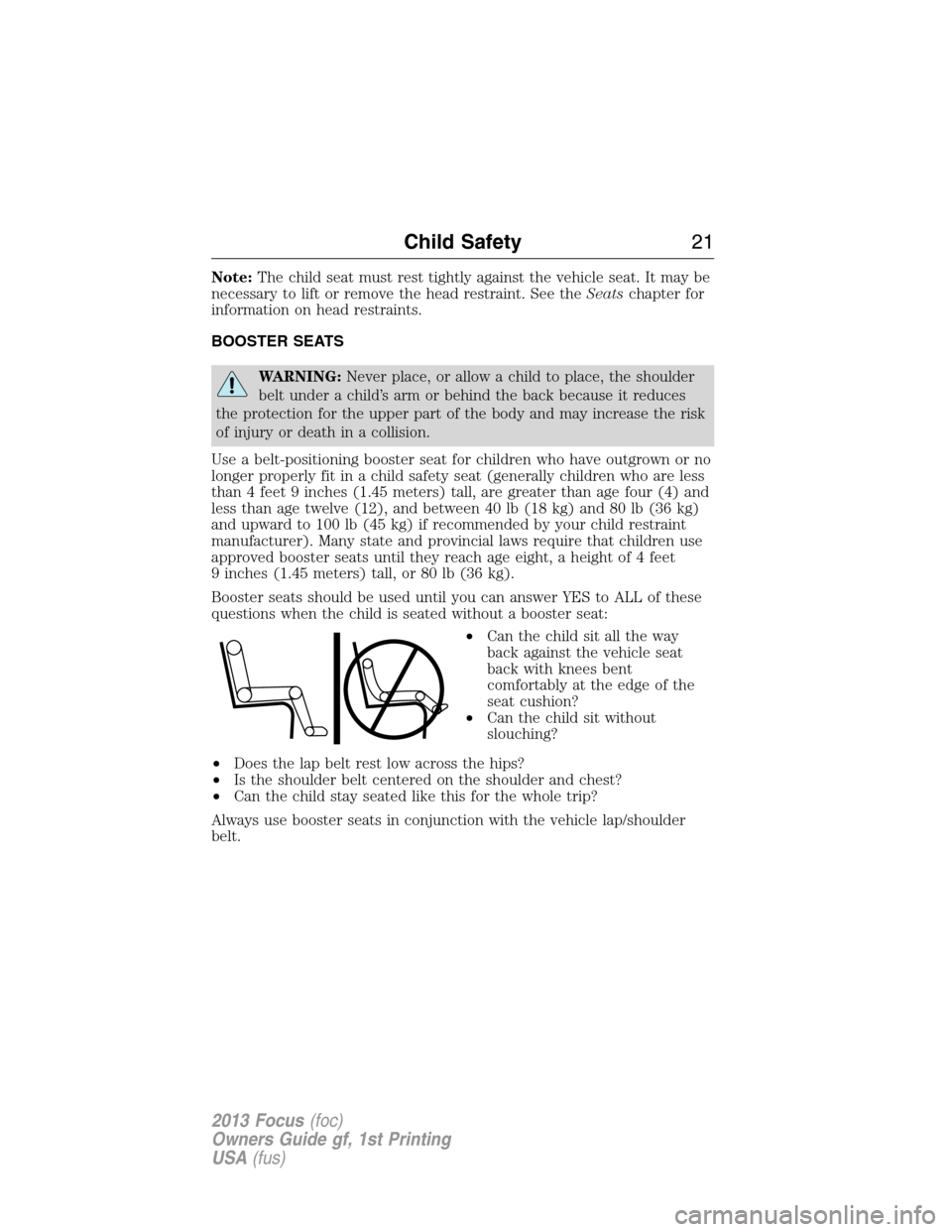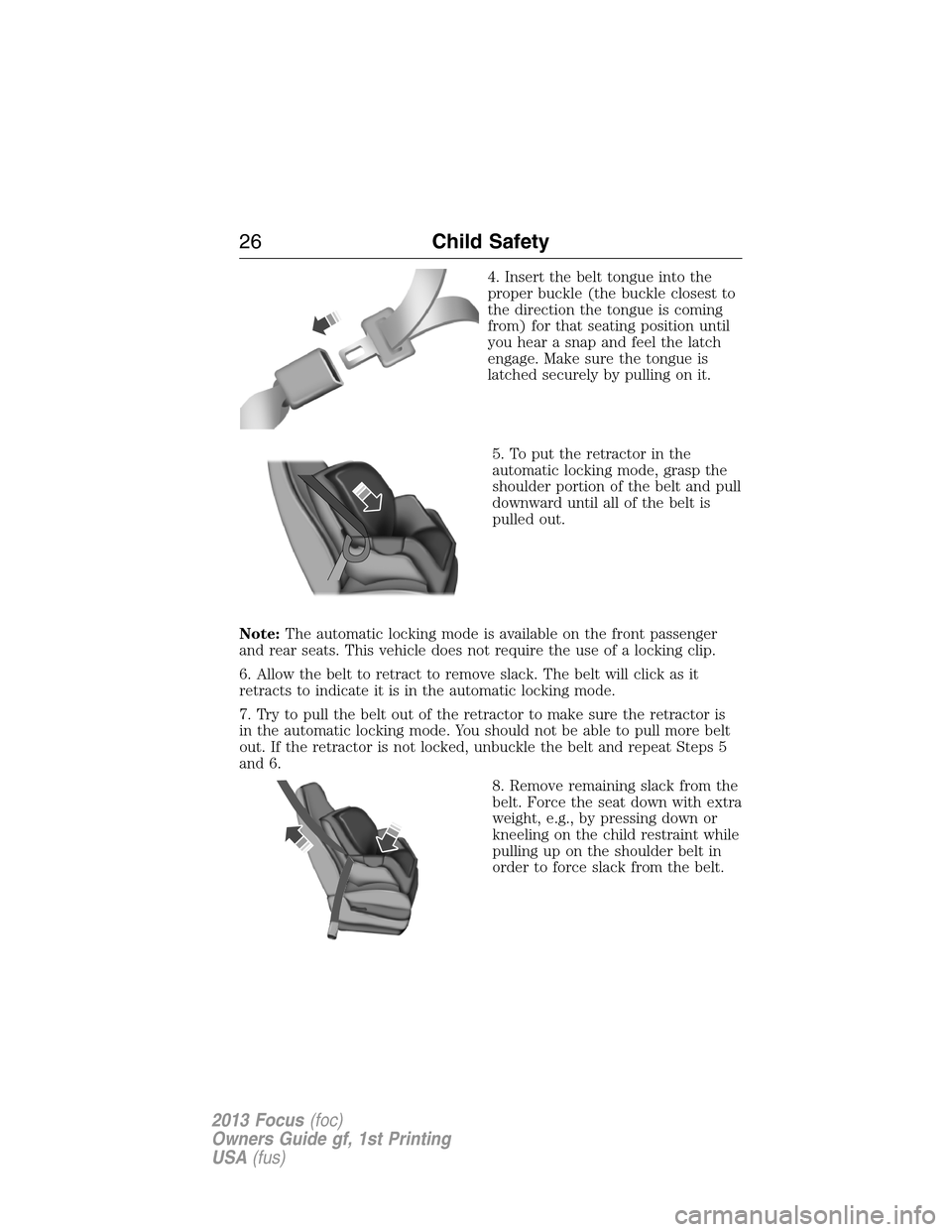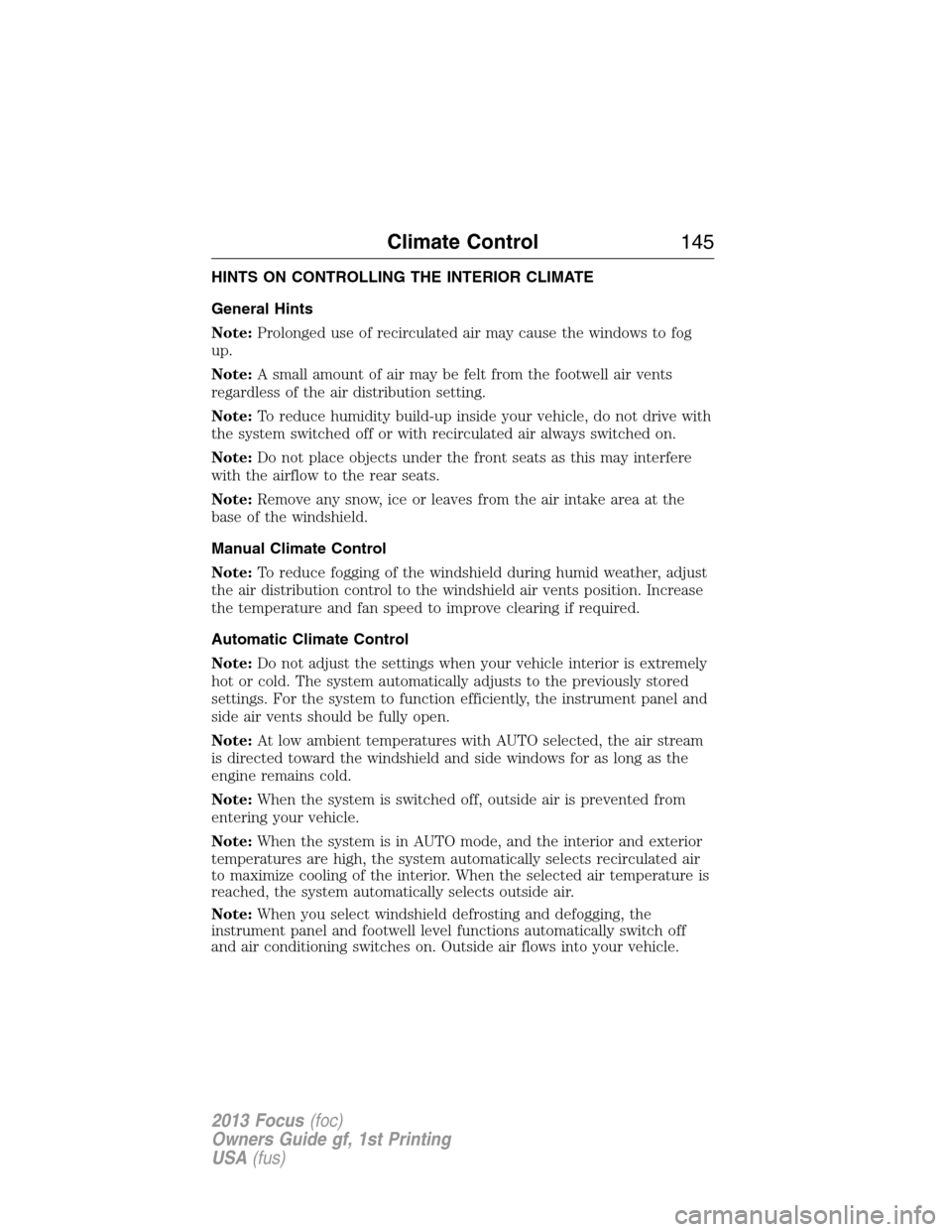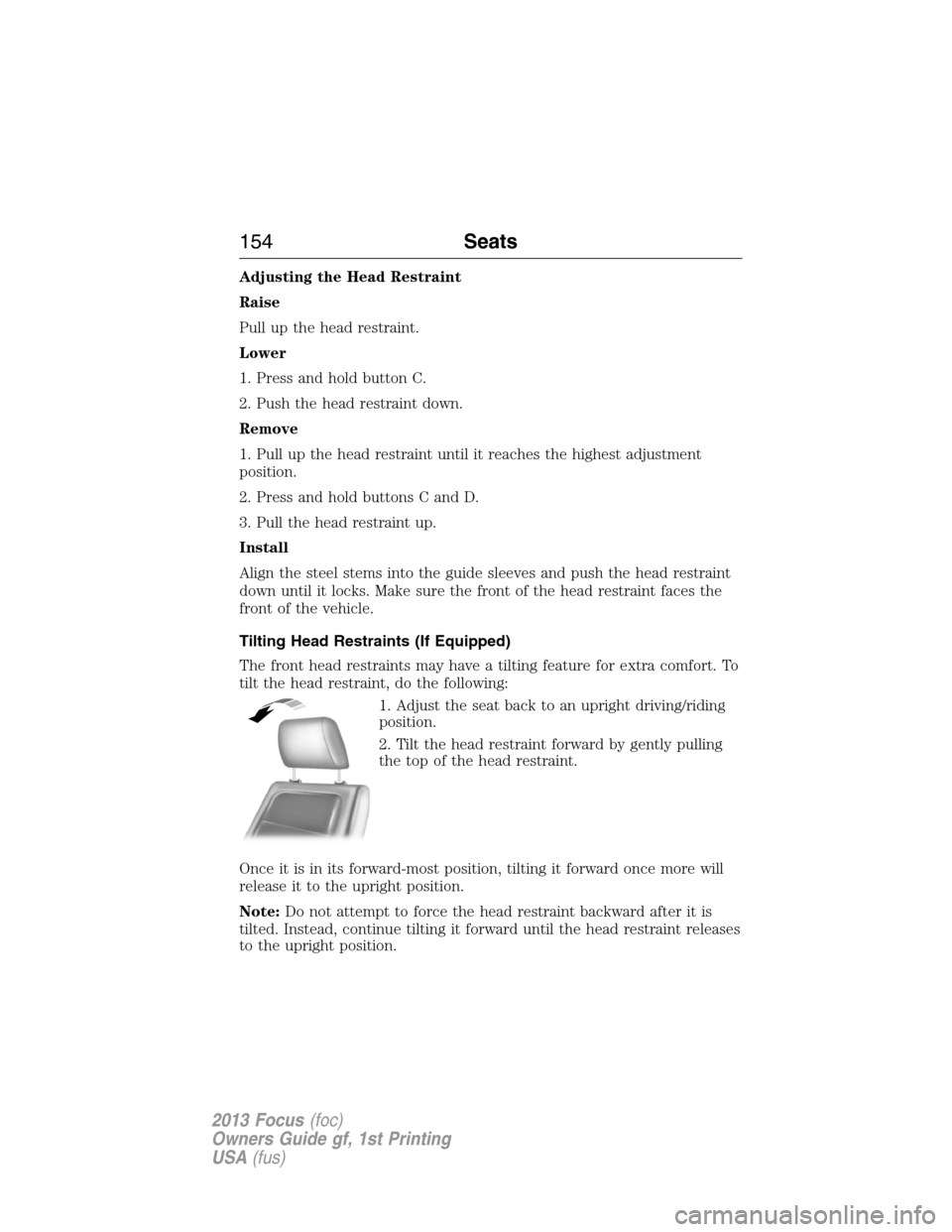Page 21 of 475

Note:The child seat must rest tightly against the vehicle seat. It may be
necessary to lift or remove the head restraint. See theSeatschapter for
information on head restraints.
BOOSTER SEATS
WARNING:Never place, or allow a child to place, the shoulder
belt under a child’s arm or behind the back because it reduces
the protection for the upper part of the body and may increase the risk
of injury or death in a collision.
Use a belt-positioning booster seat for children who have outgrown or no
longer properly fit in a child safety seat (generally children who are less
than 4 feet 9 inches (1.45 meters) tall, are greater than age four (4) and
less than age twelve (12), and between 40 lb (18 kg) and 80 lb (36 kg)
and upward to 100 lb (45 kg) if recommended by your child restraint
manufacturer). Many state and provincial laws require that children use
approved booster seats until they reach age eight, a height of 4 feet
9 inches (1.45 meters) tall, or 80 lb (36 kg).
Booster seats should be used until you can answer YES to ALL of these
questions when the child is seated without a booster seat:
•Can the child sit all the way
back against the vehicle seat
back with knees bent
comfortably at the edge of the
seat cushion?
•Can the child sit without
slouching?
•Does the lap belt rest low across the hips?
•Is the shoulder belt centered on the shoulder and chest?
•Can the child stay seated like this for the whole trip?
Always use booster seats in conjunction with the vehicle lap/shoulder
belt.
Child Safety21
2013 Focus(foc)
Owners Guide gf, 1st Printing
USA(fus)
Page 22 of 475
Types of Booster Seats
•Backless booster seats
If your backless booster seat has a removable shield, remove the shield.
If a vehicle seating position has a low seat back or no head restraint, a
backless booster seat may place your child’s head (as measured at the
tops of the ears) above the top of the seat. In this case, move the
backless booster to another seating position with a higher seat back or
head restraint and lap/shoulder belts, or consider using a high back
booster seat.
•High back booster seats
If, with a backless booster seat, you cannot find a seating position that
adequately supports your child’s head, a high back booster seat would be
a better choice.
22Child Safety
2013 Focus(foc)
Owners Guide gf, 1st Printing
USA(fus)
Page 26 of 475

4. Insert the belt tongue into the
proper buckle (the buckle closest to
the direction the tongue is coming
from) for that seating position until
you hear a snap and feel the latch
engage. Make sure the tongue is
latched securely by pulling on it.
5. To put the retractor in the
automatic locking mode, grasp the
shoulder portion of the belt and pull
downward until all of the belt is
pulled out.
Note:The automatic locking mode is available on the front passenger
and rear seats. This vehicle does not require the use of a locking clip.
6. Allow the belt to retract to remove slack. The belt will click as it
retracts to indicate it is in the automatic locking mode.
7. Try to pull the belt out of the retractor to make sure the retractor is
in the automatic locking mode. You should not be able to pull more belt
out. If the retractor is not locked, unbuckle the belt and repeat Steps 5
and 6.
8. Remove remaining slack from the
belt. Force the seat down with extra
weight, e.g., by pressing down or
kneeling on the child restraint while
pulling up on the shoulder belt in
order to force slack from the belt.
26Child Safety
2013 Focus(foc)
Owners Guide gf, 1st Printing
USA(fus)
Page 27 of 475

This is necessary to remove the remaining slack that will exist once the
additional weight of the child is added to the child restraint. It also helps
to achieve the proper snugness of the child seat to the vehicle.
Sometimes, a slight lean towards the buckle will additionally help to
remove remaining slack from the belt.
9. Attach the tether strap (if the child seat is equipped). SeeUsing
Tether Strapslater in this chapter.
10. Before placing the child in the
seat, forcibly move the seat forward
and back to make sure the seat is
securely held in place.
To check this, grab the seat at the belt path and attempt to move it side
to side and forward and back. There should be no more than 1 inch (2.5
centimeters) of movement for proper installation.
Ford recommends checking with a NHTSA Certified Child Passenger
Safety Technician (CPST) to make certain the child restraint is properly
installed. In Canada, check with your local St. John Ambulance office for
referral to a CPST.
Using Lower Anchors and Tethers for CHildren (LATCH)
WARNING:Never attach two child safety seats to the same
anchor. In a crash, one anchor may not be strong enough to hold
two child safety seat attachments and may break, causing serious injury
or death.
WARNING:Depending on where you secure a child restraint,
and depending on the child restraint design, you may block
access to certain safety belt buckle assemblies and/or LATCH lower
anchors, rendering those features potentially unusable. To avoid risk of
injury, occupants should only use seating positions where they are able
to be properly restrained.
Child Safety27
2013 Focus(foc)
Owners Guide gf, 1st Printing
USA(fus)
Page 145 of 475

HINTS ON CONTROLLING THE INTERIOR CLIMATE
General Hints
Note:Prolonged use of recirculated air may cause the windows to fog
up.
Note:A small amount of air may be felt from the footwell air vents
regardless of the air distribution setting.
Note:To reduce humidity build-up inside your vehicle, do not drive with
the system switched off or with recirculated air always switched on.
Note:Do not place objects under the front seats as this may interfere
with the airflow to the rear seats.
Note:Remove any snow, ice or leaves from the air intake area at the
base of the windshield.
Manual Climate Control
Note:To reduce fogging of the windshield during humid weather, adjust
the air distribution control to the windshield air vents position. Increase
the temperature and fan speed to improve clearing if required.
Automatic Climate Control
Note:Do not adjust the settings when your vehicle interior is extremely
hot or cold. The system automatically adjusts to the previously stored
settings. For the system to function efficiently, the instrument panel and
side air vents should be fully open.
Note:At low ambient temperatures with AUTO selected, the air stream
is directed toward the windshield and side windows for as long as the
engine remains cold.
Note:When the system is switched off, outside air is prevented from
entering your vehicle.
Note:When the system is in AUTO mode, and the interior and exterior
temperatures are high, the system automatically selects recirculated air
to maximize cooling of the interior. When the selected air temperature is
reached, the system automatically selects outside air.
Note:When you select windshield defrosting and defogging, the
instrument panel and footwell level functions automatically switch off
and air conditioning switches on. Outside air flows into your vehicle.
Climate Control145
2013 Focus(foc)
Owners Guide gf, 1st Printing
USA(fus)
Page 153 of 475
Front Seat Head Restraints
Rear Seat Outboard Head Restraints
Rear Seat Center Head Restraints
The head restraints consist of:
A. An energy absorbing head restraint
B. Two steel stems
C. Guide sleeve adjust and release button
D. Guide sleeve unlock and remove button
Seats153
2013 Focus(foc)
Owners Guide gf, 1st Printing
USA(fus)
Page 154 of 475

Adjusting the Head Restraint
Raise
Pull up the head restraint.
Lower
1. Press and hold button C.
2. Push the head restraint down.
Remove
1. Pull up the head restraint until it reaches the highest adjustment
position.
2. Press and hold buttons C and D.
3. Pull the head restraint up.
Install
Align the steel stems into the guide sleeves and push the head restraint
down until it locks. Make sure the front of the head restraint faces the
front of the vehicle.
Tilting Head Restraints (If Equipped)
The front head restraints may have a tilting feature for extra comfort. To
tilt the head restraint, do the following:
1. Adjust the seat back to an upright driving/riding
position.
2. Tilt the head restraint forward by gently pulling
the top of the head restraint.
Once it is in its forward-most position, tilting it forward once more will
release it to the upright position.
Note:Do not attempt to force the head restraint backward after it is
tilted. Instead, continue tilting it forward until the head restraint releases
to the upright position.
154Seats
2013 Focus(foc)
Owners Guide gf, 1st Printing
USA(fus)
Page 159 of 475
Folding the Rear Seats
Note:Before lowering the seat back(s), remove the outboard head
restraints.
To lower the seat back(s) from inside the vehicle, do the following:
1. Press the unlock buttons (A)
down.
2. Push the seat back forward.
Note:Your vehicle may have split
seat backs that must be folded
individually.
3. Stow the safety belt in the belt
stowage clip. This will prevent the
safety belt from getting caught in
the seat latch.
AA
Seats159
2013 Focus(foc)
Owners Guide gf, 1st Printing
USA(fus)